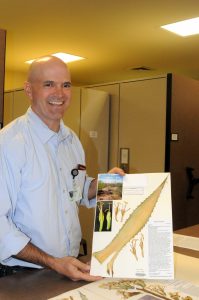Phoenix, Nov 23 (EFE).- The discovery of a species of agave never known before in modern times sheds new light on one of Arizona’s pre-Columbian cultures and how its people survived in the region’s inhospitable southern desert.
Thanks to this agave, given the scientific name of “sanpedroensis” because it was found along the San Pedro River, it is known that the Hohokam culture (800-1450 AD) knew how to domesticate plants capable of resisting the heat and drought of the desert in order to grow them as food crops.
“This is a significant discovery because it is living proof, backed by archaeological evidence, that the Hohokam grew large-scale agave crops on mounds of rocks with sophisticated irrigation systems,” botanist Andrew Salywon, discoverer of the “Agave sanpedroensis” together with Wendy Hodgson, told EFE.

The discovery came “accidentally when archaeologist William Doelle made a study of indigenous sites. Upon seeing the photos, we noticed a species of agave never seen before,” Salywon said.
In the late 1990s, a group of archaeologists began to document ancient croplands along 60 miles (96km) of the San Pedro River.
During their work they found tubular stone knives, which they believe were used by the Hohokam to harvest and process the agave that was later part of their diet.
The agave, a “monocotyledon” of the “Agavaceae” family, also known as a maguey, began to diversify 12 million years ago and now more than 300 species are known.
Salywon, who is curator of the Herbarium of the Desert Botanical Garden in Phoenix, said that according to a molecular study, the “sanpedroensis” species is exactly the same plant that was grown by the Hohokam in pre-Columbian days.
“We know that this agave was only produced by humans, because the wild species gives fruit…this is a domesticated plant,” he said.
Up to now only 200 of these plants have been found at the 12 sites being studied in the Arizona desert.
Salywon, who is also a member of the International Union for Conservation of Nature (IUCN), said the native Americans cooked agave in ovens, whose remains are still to be found in the area. They also used the plant in their rituals.
He noted that once that ethnic group disappeared following its collapse between 1300-1400 AD, the “sanpedroensis” species was forgotten.
“When the Spaniards arrived, the Hohokam like many indigenous cultures no longer existed, and this agave species was lost, but when archaeologists found the architectural sites of that ethnicity, the species was back again,” Salywon said.
